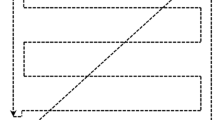Abstract
A survey was undertaken in S.W. England to study epiphyte differentiation between free-standing oak (Quercus petraea) and ash (Fraxinus excelsior) trunks. Epiphyte cover was measured on 23 trees in 87 15×15 cm quadrats positioned on the north, east, south and west faces of each trunk at a height of 1.52 m. Measurements of 20 environmental factors were made at each quadrat position.
Analysis of the vegetation data by reciprocal averaging showed that floristic variation is continuous and corresponds only partially to phorophyte identity. Rank correlation coefficients were calculated between the floristic axis obtained by reciprocal averaging, and individual environmental factors including a variate, obtained by principal components analysis of the environmental data, which expressed the major differences between the oak and ash environments. The most significant correlation was obtained with bark pH.
Values of bark pH for oak and ash samples overlapped considerably although the mean for ash (5.1) is higher than for oak (4.7). It is concluded that the epiphytic flora is responding to variations in bark acidity or some closely related factor and not to other, closely phorophyte dependent nutritional factors. Factors influencing bark acidity in oak and ash are briefly discussed.
Similar content being viewed by others
References
Allen, S. E., 1974. Chemical analysis of ecological materials. Blackwell Scient. Publ. Oxford.
Barkman, J. J., 1958. Phytosociology and ecology of eryptogamic epiphytes. Van Goreum, Assen.
Bates, J. W., 1975. A quantitative investigation of the saxicolous bryophyte and lichen vegetation of Cape Clear Island, County Cork. J. Ecol. 63: 143–162.
Bates, J. W., 1978. The influence of metal availability on the bryophyte and macrolichen vegetation of four rock types on Skye and Rhum. J. Ecol. 66: 457–482.
Beals, E. W., 1965. Ordination of some corticolous cryptogamic communities in south-central Wisconsin. Oikos 16: 1–8.
Brodo, I. W., 1973. Substrate ecology. In: (V. A.Ahmadjan and M. E.Hale, eds) The lichens. pp. 401–441. Academic Press, New York and London.
Brown, D. H. & DiMeo, J. A., 1972. Influence of local maritime conditions on the distribution of two epiphytic lichens. Lichenologist 5: 305–310.
Coppins, B. J., 1976. Distributional patterns shown by epiphytie lichens in the British Isles. In: (D. H.Brown, D. L.Hawksworth and R. H.Bailey, eds) Lichenology: Progress and Problems, pp. 249–278. Academic Press, London.
Culberson, W. L., 1955. The corticolous communities of lichens and bryophytes in the upland forests of northern Wisconsin. Ecol. Monogr. 25: 215–231.
Dennis, R. W. G., 1978. British Ascomycetes. J. Cramer.
Gauch, H. G., Whittaker, R. H. & Wentworth, T. R., 1977. A comparative study of reciprocal averaging and other ordination techniques. J. Ecol. 65: 157–174.
Greig Smith, P., 1964. Quantitative plant ecology. 2nd ed. Butterworth, London.
Hale, M. E., 1955. Phytosociology of corticolous eryptogams in the upland forests of southern Wisconsin. Ecology 36: 45–63.
Hawksworth, D. L., James, P. W. & Coppins, B. J., 1980. Checklist of British lichen-forming, lichenicolous and allied fungi. Lichenologist 12: 1–115.
Hawksworth, D. L. & Rose, F., 1970. Qualitative scale for estimating sulphur dioxide air pollution in England and Wales using epiphytic lichens. Nature. Lond. 277: 145–148.
Hill, M. O., 1973. Reciprocal averaging: An eigenvector method of ordination. J. Ecol. 61: 237–249.
Hill, M. O., Bunce, R. G. H. & Shaw, M. W., 1975. Indicator species analysis, a divisive polythetic method of classification, and its application to a survey of the native pinewoods of Scotland. J. Ecol. 63: 597–613.
Jesberger, J. A. & Sheard, J. W., 1973. A quantitative study and multivariate analysis of corticolous lichen communities in the southern boreal forest of Saskatchewan. Can. J. Bot. 51: 185–201.
Kenkel, N. C. & Bradfield, G. E. Ordination of epiphytic bryophyte communities in a wet temperate coniferous forest, southcoastal British Columbia. Vegetatio.
Mengel, K. & Kirkby, E. A., 1978. Principles of plant nutrition. Intern. Potash Inst. Bern.
Paton, J. A., 1965. Census catalogue of British hepatics. 4th ed. Brit. Bryol. Soc., Ipswich.
Smith, A. J. E., 1978. The moss flora of Britain and Ireland. Cambridge University Press.
Author information
Authors and Affiliations
Additional information
Nomenclature follows Paton (1965) for liverworts, Smith (1978) for mosses, Hawksworth, James & Coppins (1980) for lichens and Dennis (1978) for ascomycetes.
We wish to thank Dr. D. L. Hawksworth for identification of some of the lichen specimens. M. O. Hill kindly provided advice on the use of downweighting in reciprocal averaging and Dr. A. J. Morton commented on a draft of the manuscript.
Rights and permissions
About this article
Cite this article
Bates, J.W., Brown, D.H. Epiphyte differentiation between Quercus petraea and Fraxinus excelsior trees in a maritime area of South West England. Vegetatio 48, 61–70 (1981). https://doi.org/10.1007/BF00117362
Accepted:
Published:
Issue Date:
DOI: https://doi.org/10.1007/BF00117362




